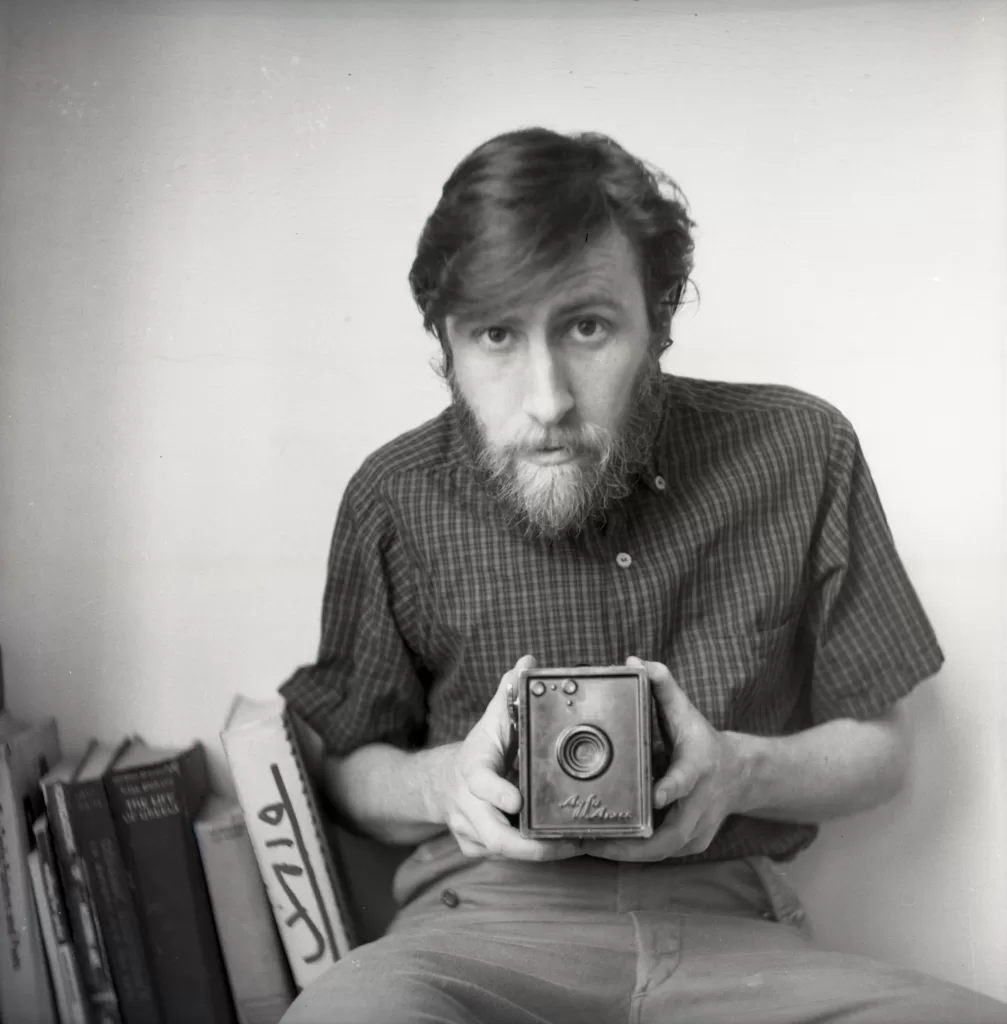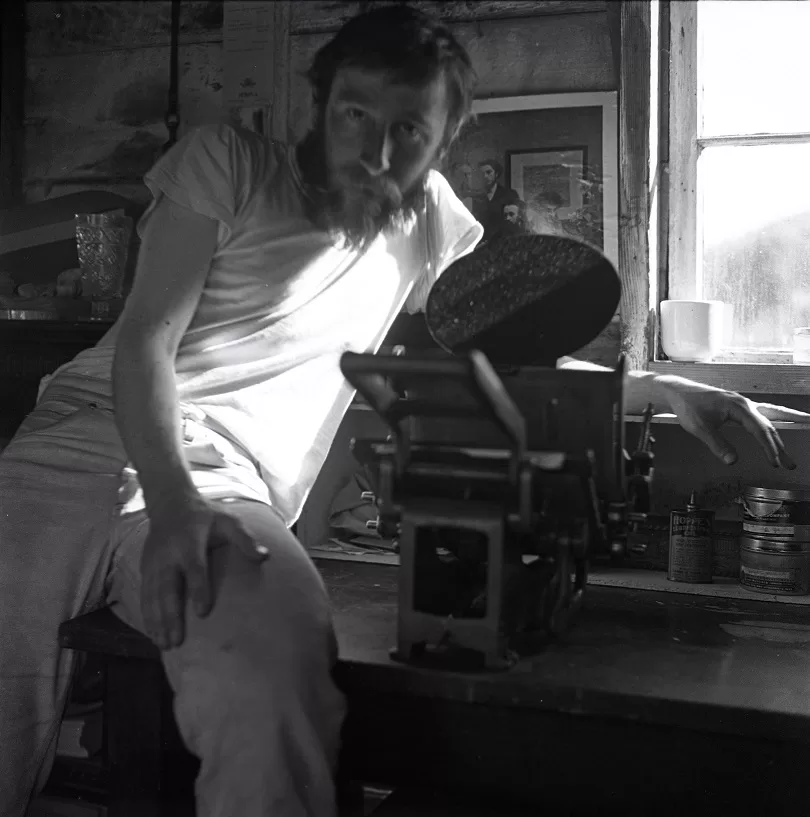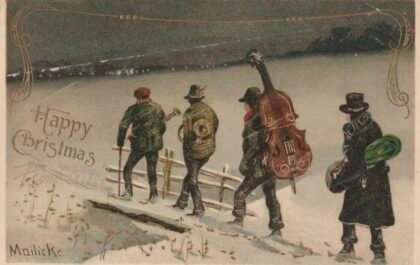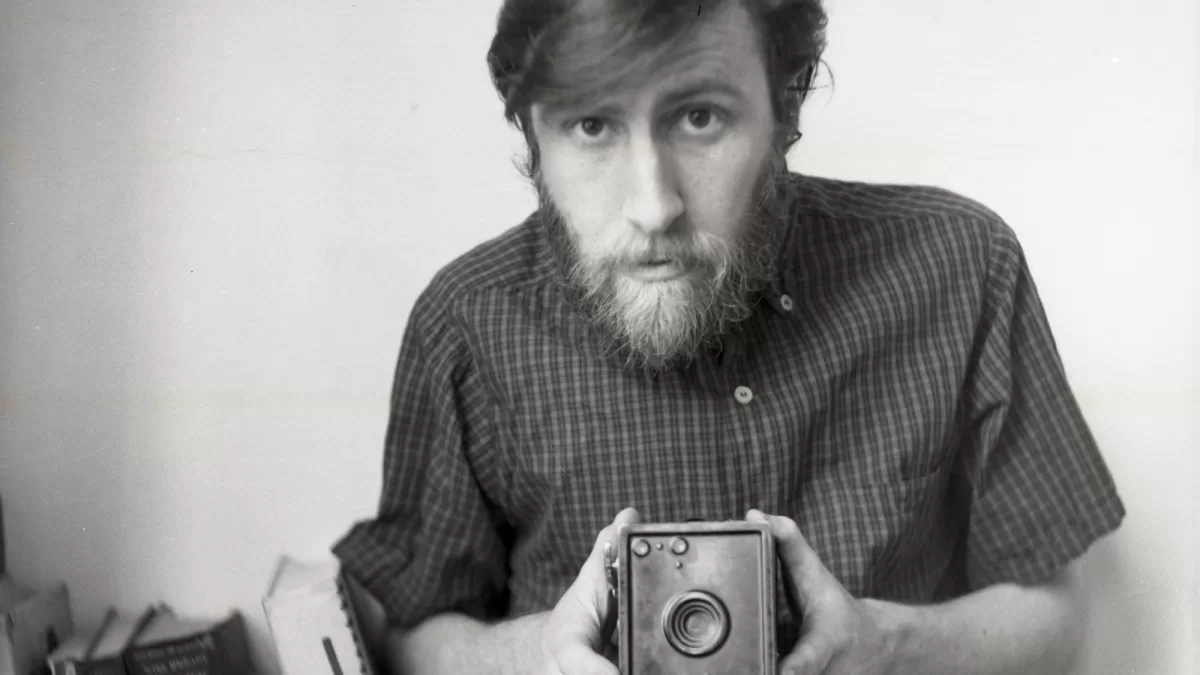
Los Angeles cultural historian Emmeline Summerton. Lost Canyons LA explores the evocative siren call that has been bringing newcomers to the Santa Monica Mountain region for more than a century and shares the stories of people seeking adventure, creativity, and new ways of living in this unique oasis of nature and beauty.
Topanga Canyon has long been recognized as Los Angeles’ most bohemian and artistic canyon, a label it earned during the 1960s when it became a magnet for a new generation of underground artists. In this month’s Lost Canyons LA column we’re exploring Topanga’s mid century arts scene through the life of artist Wallace Berman and his eclectic circle of friends that included Topanga locals Dennis Hopper, Dean Stockwell, Russ Tamblyn and George Herms.
Considered by many as the father of the California art assemblage movement, Wallace Berman pioneered the use of a modified Kodak Verifax copier to create layered, mix-media collages using magazine and newspaper images. Berman was also known for his art and literature magazine Semina, which was filled with copies of hand-made collages, individually numbered and signed, and mailed to only a select group of readers.
The influential Semina has been described as a “museum without walls,” combining Berman’s photos and collages with the work of other writers and artists, many of whom became known as part of a collective centered around the magazine. Contributors whose work appeared in Semina include Hermann Hesse, Charles Bukowski, William S. Burroughs and Allen Ginsberg. Berman’s influence on modern art was immortalized when his photo was included on the cover of The Beatles’ Sgt. Pepper’s Lonely Hearts Club Band in 1967.
Wallace Berman was born in Staten Island in 1926 and moved to Los Angeles with his mother and grandparents in the early 1930s, following his father’s death. The family eventually settled in the Fairfax District, where a young Berman would befriend another neighborhood boy, Sammy Davis Jr.
Unconventional from the start, a teenaged Berman listened to jazz, hung out at swing clubs, dressed in a zoot suit, and had a hustler’s affinity for the life of an outsider. A knack for gambling saw him expelled from Fairfax High School, followed by brief stints in the US Navy and the Chouinard Art Institute; two institutions he was similarly expelled from. Berman had his first taste of artistic success after Dial Records boss, Ross Russell hired him to do the artwork for the 1947 compilation album Be-Bop Jazz, made famous for having the first 78-rpm recording of jazz legend Charlie Parker. Not long after, Berman met the woman who would become his wife and muse, Shirley Morand, who first spotted him through the window of her Hollywood ballet studio driving a convertible car with a cat wrapped around his shoulders.
In his book, Growing Up Tosh, the couple’s son Tosh Berman writes that at the time his father never left home without his cat, inspired by the nineteenth-century French writer Gérard de Nerval, who would take walks through Paris with his pet lobster attached to a silk leash.
The couple were married in 1952 and moved into a hillside one-bedroom home on Crater Lane in Beverly Glen from which they would build a new art scene that included Beat poets, musicians, actors, and fellow outsider artists.
Up until 1960, L.A. had no modern art museums and very few galleries (*) which gave artists such as Berman, Ed Ruscha and Judy Chicago free reign to create their own unique movement. (*) In 1955 Berman opened Stone Brothers Printing in partnership fellow artist Robert Alexander. Their storefront studio space became a makeshift gallery and printing press for Semina. One regular visitor to Stone Brothers was Dennis Hopper, then beginning his life-long interest in modern art and the artists who created it. In his book, Berman’s son Tosh writes that legend says Hopper brought his Rebel Without a Cause co-star James Dean to the studio, a claim that has unfortunately never been verified. Hopper did, however, introduce Berman to another acting friend, Dean Stockwell who would later play a significant role in his life.
In 1957, Berman held his first show at the Ferus Gallery in West Hollywood. It had only recently been opened by gallerists Walter and Shirley Hopps and fellow assemblage artist Ed Kienholz. The exhibition was raided by the LAPD Vice Squad two weeks after it opened following an anonymous tip complaining about the alleged pornographic nature of Berman’s assemblage piece Temple, which included a copy of a sexually explicit drawing by the artist Cameron. Berman was arrested for “displaying lewd and pornographic matter” and after two days in jail was found guilty and fined $150. A fine that was paid by his friend Dean Stockwell. (*) Following this event Berman, who would never mount another commercial gallery exhibition, (*)moved his family north to live for a few years immersed in the Beat scene of San Francisco and the Bay Area, where he continued to work on the Semina publications.

Returning to their Beverly Glen home in 1961, Wallace and Shirley Berman once again took up their position as a central hub for the L.A. art scene. (*) One memorable occasion took place at the home when Andy Warhol was in town for his second show at the Ferus Gallery in 1963. Warhol and his entourage started filming Tarzan and Jane Regained, Sort Of…, his first full-length movie, in a bathroom of the Beverly Hills Hotel. (*) The action then moved to the Bermans’ home, where both Wallace and Tosh Berman, alongside Dennis Hopper, his wife Brooke Hayward and the artist Claes Oldenburg all filmed bit parts for the movie. This wasn’t Berman’s only on screen appearance. Hopper would later cast him in the commune scene in Easy Rider filmed in the Santa Monica Mountains. Of Berman, Hopper once said he “filled the void for all of us. It was more about living the life of an artist than necessarily being an artist.
In 1965, disaster struck the Berman family. when their hillside home and most of their possessions were destroyed in a mudslide. As he had after Berman’s arrest, Dean Stockwell stepped in and bought the family a home on Arteique Road in Topanga Canyon. Writing in his book Growing Up Tosh, Berman’s son said it was a move that sparked the beginning of the family’s “golden era of Topanga.” Many of their friends were already living in the community, including Stockwell and soon-to-be-friends Russell Tamblyn and Billy Gray who, like Stockwell, had both been child actors. Tamblyn and Stockwell were particularly drawn into Berman’s artistic influence and were both inspired to explore their own creativity by working within the assemblage medium. Tamblyn converted his home bowling alley into a theater where the group would screen art films made by Berman and Stockwell.
In his memoir, Tosh Berman writes that despite his father’s reputation as being a recluse, he was a very social person in the Topanga community. “I don’t think my parents turned down one picnic, beer party, Topanga fair, Topanga concert, or benefit for drug dealers who got busted or musicians who couldn’t pay their rent or lost their instruments,” he writes.
Two important members of Berman’s Topanga circle were the artist George Herms, who was part of the group of artists involved in Semina in Northern California, and Marjorie Cameron, whose photo appeared on the first issue of Semina magazine and whose artwork Peyote Vision was the catalyst to Berman’s 1957 obscenity conviction.
In 1955, Herm was staying with a friend in Topanga Canyon when he met Berman and his Stone Brothers Printing partner Robert Alexander on his twentieth birthday. Berman became a mentor to Herms who would later go on to help him set up his ill-fated 1957 show at Ferus Gallery. That same year, Herms mounted a self-curated solo show called Secret Exhibition on a vacant lot on Hermosa Beach. An assemblage piece made up entirely of found objects, the show was only ever viewed by Berman and fellow artist John Reed before it was allowed to decompose.
Marjorie Cameron, who preferred to be known only by her last name, was a spiritualist and mystic artist. She was once married to Jack Parsons, the notorious head of the Jet Propulsion Laboratory in Pasadena, and a follower of occultist Aleister Crowley. Cameron was close friends with Wallace and Shirley Berman, often staying with them at their homes in Beverly Glen and Topanga.
Berman first saw Cameron’s drawing Peyote Vision at an esoteric bookstore where she was living in a back room. The drawing depicts sex between a fork-tongued woman and a demon and was considered incredibly shocking at the time. Intrigued by the work, Berman included the piece inside the first edition of his Semina magazine that also had Cameron on its cover. After Berman’s arrest for including the same image in his Ferus Gallery show, Cameron joined the family when they retreated to Northern California to work.
Another member of the Bermans’ new Topanga community was Stockwell’s then girlfriend Toni Basil. Long before she became famous for her hit 1981 song Hey Mickey, Basil was an important bridge between Berman and the unfolding 1960s music world. At the time the Bermans moved to Topanga, Basil was working as a dancer and choreographer on the TV show Shindig! with other credits that included Elvis Presley’s Vive Las Vegas and a dancing scene with Davy Jones in the Monkees’ film Head in 1968. A great connector of people, Basil was responsible for introducing Berman to the Rolling Stones’ Brian Jones, who became a regular visitor to his home.
Berman lived in Topanga for 11 years, becoming an integral part of the community. He would readily agree to doing design work or donate artworks to support local causes. A regular at the legendary Topanga Corral (where his son Tosh is sure he had a permanent beer tab) he went out of his way to support local artists he liked and admired, once presenting performance artist Harry Kipper at the Mermaid Tavern, where he not only designed the poster but also put it up all over town in the middle of the night. Sadly, Wallace Berman was killed by a drunk driver in Topanga Canyon on February 18, 1976, the day of his 50th birthday.
Berman’s work was most recently exhibited by the Kohn Gallery in Hollywood and many of his pieces are available to view online at www.getty.edu.
END NOTES
- Surrealism Meets Kabbalah: The Place of Semina in Mid-Century California Poetry and Art https://writing.upenn.edu/library/Fredman-Stephen_Semina.html
- Growing Up Tosh by Tosh Berman
- Surrealism (n 1)
- The Guide, https://theguide.art/event/wallace-berman-off-the-grid-totah/
- Berman (n 2)
- Rebels in Paradise, Hunter Drohojowska-Phillip
- Art Forum, https://www.artforum.com/print/197802/wallace-berman-portrait-of-the-artist-as-an-underground-man-37245
- Growing Up Tosh by Tosh Berman
- Art Forum (n 7)
- Berman (n 2)
- Ibid
- Warholstars.org https://warholstars.org/tarzan-jane-regained.html
- Berman (n 2)
- IMDB.com https://www.imdb.com/title/tt0064276/locations
- Everybody Thought We Were Crazy by Mark Rozzo
- Play Anything You Want: Mark Allen and George Herms in Conversation https://eastofborneo.org/articles/play-anything-you-want-mark-allen-and-george-herms-in-conversation/
- LA Review of Books, https://lareviewofbooks.org/article/cameron-witch-art-world/
- LA Times, https://lareviewofbooks.org/article/cameron-witch-art-world/
- The George Herms Papers, https://oac.cdlib.org/findaid/ark:/13030/kt7m3nf5vx/entire_text/
- Getty Museum, https://blogs.getty.edu/pacificstandardtime/explore-the-era/people/marjorie-cameron/
- Growing Up Tosh by Tosh Berman
- Ibid






Hi Emmeline,
My husband Ral Curren owned the Corral and was a friend of Wally’s . He recently passed away but he always spoke highly of Wally and we have two of his silkscreens that Wally traded for his bar tab. Ral told me that Wally would constantly tell him to come and pick out a painting in exchange for his bar tab but he never made it over to his house. Wally was struck by a car and the Canyon was heartbroken over his death.
Hello this is actress Nicole Arlyn I am excited to share with you that my 8 year old son Giosué Bottini will be having a ONe MAn ARt Show at the Artists Matter Gallery in Topanga this coming May 5th and we would love to write about him! He is also an actor, composer, mathematician , award winning film director. We are delighted beyond measure to show his art work in Topanga please come!!!!! may 5 5-9 129 S. Topanga Canyon BLvd
Hello:
This is a fascinating article, I am familiar with most of the names in my own reading and study of Art History. I’m doing research on a young woman and artist named Paige Young who lived in Topanga Canyon in the mid to late 1960s. If there is anyone around from that era, I would love to speak with them. She also lived in Malibu for a spell in a converted chicken coup. Thank you very much.